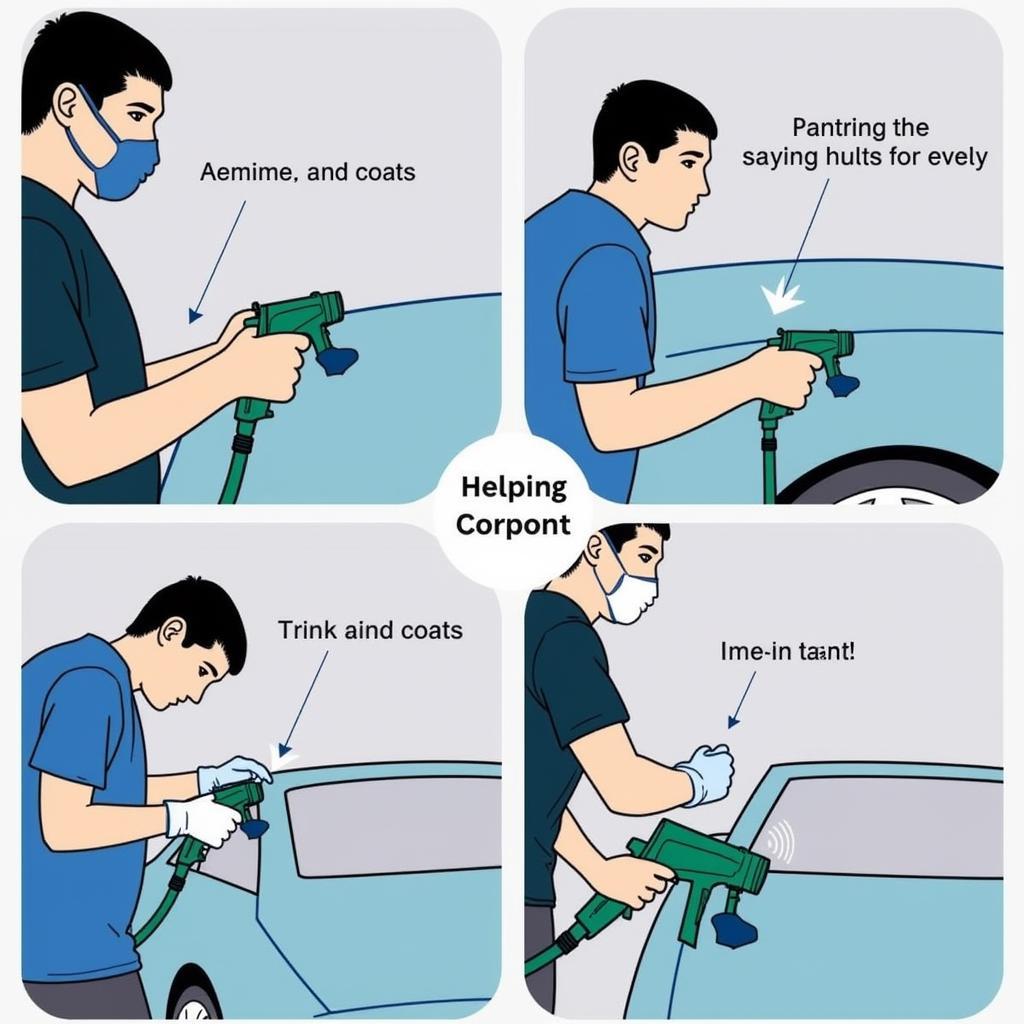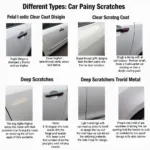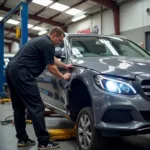DIY car paint repair can seem daunting, but with the right knowledge and preparation, you can achieve professional-looking results and save money. This guide covers everything from assessing the damage to choosing the right tools and techniques for a flawless finish. Let’s dive in!
Understanding Your Car Paint Damage
Before you begin your DIY car paint repair, it’s crucial to understand the extent of the damage. Is it a minor scratch, a deep gouge, or a widespread area of chipped paint? This initial assessment will determine the appropriate repair method. For instance, a light scuff might only require polishing, while deeper scratches necessitate diy car paint scuff repair. Properly identifying the damage type will ensure you select the correct products and techniques.
Gathering the Necessary Tools and Materials for Paint Repair Car DIY
Having the right tools and materials is paramount for a successful paint repair car DIY project. You’ll need sandpaper (various grits), primer, car paint (matched to your car’s color code), clear coat, masking tape, a tack cloth, rubbing compound, and polishing compound. Additionally, applicators like spray guns, brushes, or touch-up pens can be useful depending on the damage type. Investing in quality materials ensures a better and longer-lasting repair.
Step-by-Step Guide to DIY Car Paint Repair
- Clean the Damaged Area: Thoroughly wash and dry the area to be repaired. This removes dirt and grime, ensuring proper adhesion of the repair materials.
- Sand the Damaged Area: Start with a coarser grit sandpaper to smooth out deep scratches and then progressively move to finer grits for a smooth finish. For a guide on car body paint repair, check out car body paint repair diy.
- Apply Primer (if necessary): Primer is essential for deeper scratches or chips as it provides a uniform surface for the paint to adhere to.
- Apply Paint: Carefully apply thin, even coats of paint, allowing each coat to dry before applying the next.
- Apply Clear Coat: Once the paint is dry, apply a few layers of clear coat to protect the paint and give it a glossy finish. You might find this resource on DIY car paint repair helpful: diy car paint repair.
- Sand and Polish: After the clear coat dries, wet sand with fine-grit sandpaper and then polish the area to blend the repair with the surrounding paint.
 Applying Car Paint with Spray Gun
Applying Car Paint with Spray Gun
Common Mistakes to Avoid in DIY Car Paint Repair
One common mistake is not properly preparing the surface. Failing to clean and sand the area thoroughly can lead to poor adhesion and an uneven finish. Another common error is applying thick coats of paint, which can result in runs and drips. Taking your time and applying thin coats is crucial for a professional-looking result. For insights on car dent repair and paint, see diy car dent repair and paint.
When to Consult a Professional
While many minor paint repairs can be tackled with DIY methods, some situations warrant professional help. Extensive damage, such as deep dents or rust, is best left to experienced technicians. They have the expertise and equipment to handle complex repairs effectively.
Conclusion
DIY paint repair car projects can be a cost-effective way to address minor paint damage. By following the steps outlined in this guide and avoiding common mistakes, you can achieve impressive results. However, remember to assess the damage accurately and seek professional help when necessary. For community discussions on car paint chip repair, check out car paint chip repair reddit. With patience and attention to detail, you can restore your car’s appearance and protect its value.
FAQ
- How do I match my car’s paint color?
- What type of sandpaper should I use for car paint repair?
- How long should I wait between paint coats?
- Can I repair rust myself?
- What is the best way to remove scratches from car paint?
- How can I prevent future paint damage?
- What is the difference between rubbing compound and polishing compound?
Common Car Paint Repair Scenarios
- Scenario 1: Minor scratches and scuffs caused by light contact.
- Scenario 2: Chipped paint from rocks or road debris.
- Scenario 3: Deep scratches that penetrate the clear coat.
- Scenario 4: Faded or oxidized paint due to sun exposure.
Related Resources
- Car Paint Repair Tips for Beginners
- How to Choose the Right Car Paint
- Understanding Different Types of Car Paint Damage
Need more help? Contact us via WhatsApp: +1(641)206-8880 or Email: [email protected]. We have a 24/7 customer support team.


